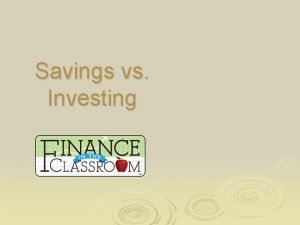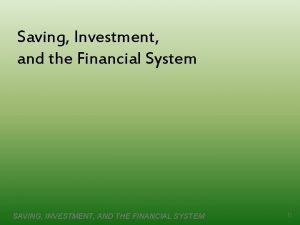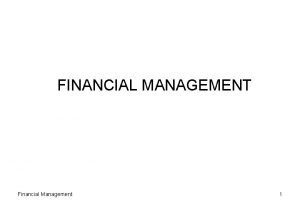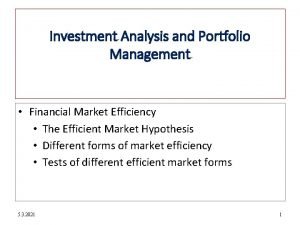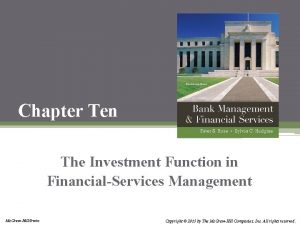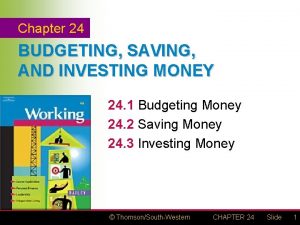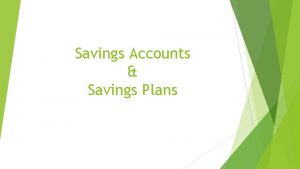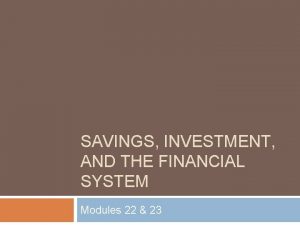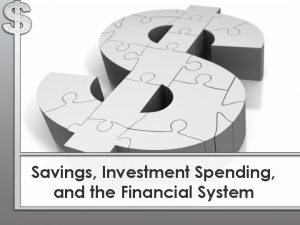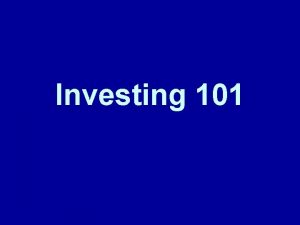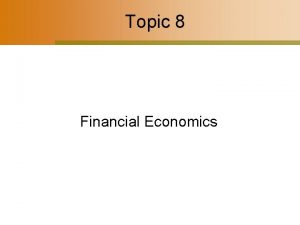Savings Investment and the Financial System Types of













- Slides: 13

Savings, Investment and the Financial System

Types of Savings Private saving q The portion of households’ disposable income that is not used for consumption q Y – TX + TR – C q Simplified as Y – T – C Public saving q Net tax revenue less government spending q TX – TR – G q Simplified as T – G

National Savings Private saving + Public savings q (Y – T – C) + (T – G) = q. Y–C–G q the portion of national income that is not used for consumption or government purchases +

Savings–Investment Identity National Income Accounting equation q. Y=C+I+G+N Assume a closed economy, so: q. Y=C+I+G Now, solve for I: q I = Y – C – G = (Y – T – C) + (T – G) national saving

Budget Balance Budget Surplus q Excess of tax revenue over government spending q T>G q Public saving Budget Deficit q Shortfall of tax revenue government spending q T<G q Public dis-saving from

US Budget Balance

International Capital Flows q In the real world, no economy is closed… q If national savings exceeds domestic investment, excess savings will “flow” out. q If domestic investment exceeds national savings, foreign savings will “flow” in.

China Savings-Investment Balance

Quick Problem Suppose the following: q q GDP = $10 trillion Consumption = $6. 5 trillion Government spending = $2. 0 trillion Budget deficit = $300 billion Now solve for the following: q q q Public savings Private savings National savings Investment Taxes

Financial System

Three Key Tasks Reducing Transaction Costs q Information on borrowers and lenders q Costs of negotiations, legal process, etc. Managing / Reducing Risk q Adverse selection and moral hazard risks q Diversification Providing Liquidity q Flexibility to convert financial asset into cash on short notice

Financial System

Types of Financial Assets (Instruments) Bank Deposits q q Claim by depositor on a bank; often on “demand” but not always Key terms: demand deposits, time deposits, CDs Loans q q Lending agreement between individual borrower and lender Common types: corporate loans, mortgages, car consumer Customized and not easily tradable (relatively illiquid) Key terms: collateralized vs. uncollateralized; fixed vs. floating interest rates Bonds q q IOU issued by borrower to many lenders simultaneously Common types: corporate, government, municipal Standardized and often tradable (relatively liquid); usually given credit rating Key terms: face value, coupon, yield, maturity Stocks q q q Share ownership in a company Perpetual and usually not redeemable, but often tradable Key terms: equities, dividend, price/earning ratio
 Savings vs investment
Savings vs investment Savings-investment spending identity
Savings-investment spending identity Mankiw chapter 26 solutions
Mankiw chapter 26 solutions National saving
National saving Saving investment and the financial system
Saving investment and the financial system Fixed investment and inventory investment
Fixed investment and inventory investment Types of production costs
Types of production costs Real estate financial analysis
Real estate financial analysis Modern financial management
Modern financial management Financial investment analysis
Financial investment analysis Gold268
Gold268 The investment function in financial services management
The investment function in financial services management Budgeting and savings
Budgeting and savings Savings and loan associations
Savings and loan associations
